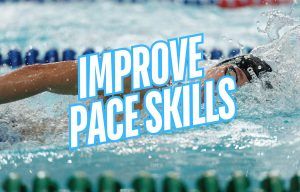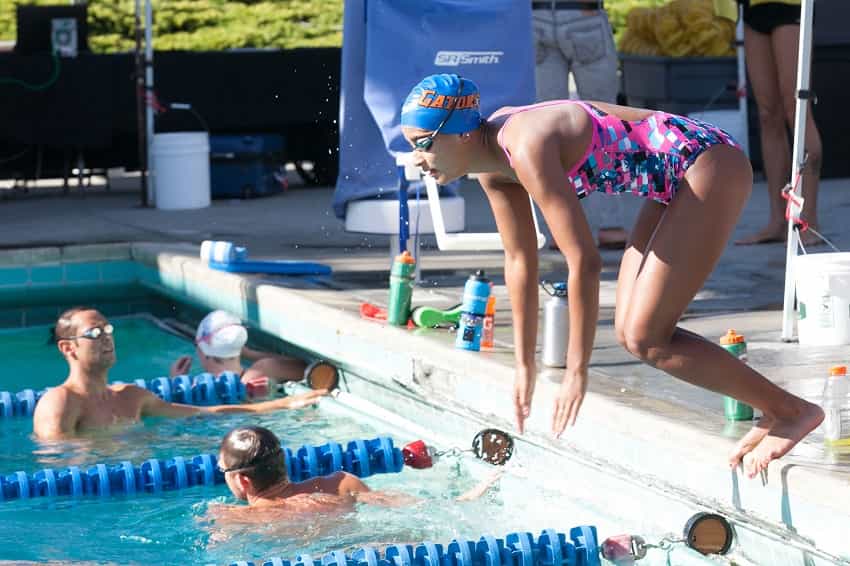
How to Improve Your Pacing Skills
Looking to up your pacing skills in the pool? Here are some actionable pacing tips and tools to help you master pace and your performance on race day.

Swimming for fitness and exercise is one of the best ways to get in shape, lose weight, and build muscle. Here is a breakdown of what you need to know to get started with swimming.
If you are intrigued by the idea of hopping into the water and swimming for exercise but don’t know where to start, this guide is for you.
We will cover some of the basics, including:
Let’s dive right in.
Full disclosure: I am fully and completely biased in saying that swimming is the best form of exercise there is.
I’ve been in and around swimming pools since I was 5 years old, and nearly 35 years later, my passion and love for the sport has only increased. My skin and hair have smelled like chlorine for the better part of four decades.
But there is a lot of research out there that supports my life-long infatuation with swimming for fitness and exercise.
Some of the health benefits of swimming for exercise include:
Swimming looks like a super simple sport when it comes to picking out the right equipment.
Pick out a pair of swim goggles and a swimsuit, and off we go!
But even something as simple in functionality like goggles and a swimsuit come in a nearly endless variety of options.
With swimsuits for lap swimming, there are drag suits, two-piece swimsuits, for the fellas—swim briefs, and even open water and triathlon wetsuits for cold water swimming.
Ultimately, you want a swimsuit that gives you a full range of motion, is at least mildly resistant to chlorine (look for suits high in polyester—they last longest), and is snug enough that it doesn’t create a ton of needless drag and resistance in the water.
Swim goggles are another essential for swimming for exercise. They help you see under the water so that you can keep an eye (or two) out for lane lines, other swimmers, and the wall.

Goggles protect your eyes from nasty chloramines which leave your eyes red and itchy. Chloramines are the yucky result of what happens when chlorine binds with sweat, pee and other “body waste” swimmers bring into the pool.
Swim goggles are generally cheap and long-lasting (look for goggles and head straps made of silicone—they are the most durable), and there are other options, including swimming masks, which give swimmers extra wide peripheral vision in the water.
Other options for protecting the eyes and enhancing underwater vision include swim goggles with nose covers, which are an excellent type of swim goggle for snorkeling and for people who struggle with getting water in their nose.
While swim caps aren’t required in the lap pool, they are a good idea as they keep hair out of your eyes, keep hair out of the pool, and protect your hair from chlorine.

One of the many perks of lap swimming is the versatility. The workout you get is ultimately only limited by your imagination.
Beginner swimmers may only be familiar with freestyle (front crawl), the stroke that you see performed most frequently at the pool. But there are three other strokes—butterfly, backstroke, breaststroke—with which you can mix things up with.
On top of that, you can design your swim workout to specifically target your upper body or lower body. Pull buoys target the upper body—shoulders, lats, arms, chest—and kickboards—one of the first swimming aids most of us come across—isolate the legs for an excellent lower body workout.
While most swimmers will jump into the water and swim unbroken freestyle for the duration of their workout, a way to increase the challenge and physical health benefits of swimming for exercise comes with doing some quick structuring of your workout.
Here is a simple way to chunk down your swim training.
Warming-up. Swim pools are often a little chilly. I’ve always found that getting warm and ready for my workout takes a little longer. Add some kicking to get the blood-flow really going. Hop in, start easy, and steadily build up to a slightly vigorous effort, giving all of your muscles—core, arms, back, legs, pulmonary—a chance to get warm.
Sample warm-up for a 60-minute swim practice:
4×100 freestyle (50 swim, 50 kick) @:30 rest between reps
The Pre-Set. The pre-set is mainly for technical proficiency. During this set, we are performing specific drill work to help improve our efficiency and technique in the water. Swimming faster isn’t just about effort—it’s about making yourself as efficient as possible in the water. The pre-set should include stroke-specific drill work and quick bursts of effort that set the stage for the main set.
Sample pre-set for a 60-minute swim practice:
6×50 as 25 freestyle drill choice, 25 swim build to 90% effort @:20 rest between reps
The Main Set. This is the meat and potatoes of your swim workout. Now that you are fully warmed up and your technique is on point, it’s time to get to work! If your goal is straight-aerobic conditioning, this is where you are doing the work. If your goal is speed and power, here’s where we do those high-intensity reps we tons of rest.
Sample main set for a 60-minute swim practice:
16×100 freestyle swim @2:00 (best average)
The Warm-Down. For swimmers on a time-crunch, it’s tempting to hop out after the last rep of the main set is over and hit the bricks. I know I’ve done this more than a few times. But taking a few minutes to unwind and warm-down speeds up recovery and ward off injury. I typically do counter-movement swimming during my warm-down to open up my chest and shoulders. For example, if I do a lot of swimming on my front doing freestyle, I will do a lot of backstroke during my warm-down.
Sample warm-down for a 60-minute swim practice:
6×50 double-arm backstroke @:25 rest between reps
If you have the time for a full workout, use each of these four sections to build a comprehensive session in the water that helps you swim with better technique, warm up properly, have enough time to crush a big main set, and some time to relax and unwind at the end.
As you spend more time swimming for fitness and exercise, and you pick up more of the swimming terminology and progressively get into better shape, you will discover the nearly endless number of ways to get better in the water.
Here are some ideas for taking your swimming fitness to the next level.
Like every form of exercise, swimming for fitness means putting together some simple goals for your time in the water, having a plan for your training, and swimming with focus and intent as you get closer to your goals.
3 Swimming Workouts for Beginners. Looking for some beginner swim workouts that you can easily adjust according to your current fitness and skill level? Here are three of my favorites.

Olivier Poirier-Leroy Olivier Poirier-Leroy is the founder of YourSwimLog.com. He is an author, former national level swimmer, two-time Olympic Trials qualifier, and swim coach.
✅ Free shipping on Orders over $49
✅ Price Match Guarantee
✅ Best selection of gear for training and competition
✅ Fast and Easy Returns

“This is the best book I have ever seen concerning mental training.” — Ray Benecki, Head Coach, The FISH Swim Team


Looking to up your pacing skills in the pool? Here are some actionable pacing tips and tools to help you master pace and your performance on race day.

Looking for tips on how to use a drag chute for improved swim performances? Read on for some proven tips, sets, and pointers for training with a chute.

Ready to take your swimming to the next level? Here are seven ways that a drag chute can help you become a better and faster swimmer.

Wondering if a swim bench can help improve your swimming? Here are six benefits of swim benches for better technique, more power, and faster swimming.

Not breathing into the walls is one of the fundamental skills developing swimmers are taught. Here is how powerful a no-breath approach is for turn and swim speed. Strong training habits are something swimmers hear a lot about from their earliest days of their competitive swimming careers. The greatest hits

Drills with a swim snorkel are one of the best ways to maximize engagement and skill development. Here are five swim snorkel drills to try for faster swimming.
SITE
SHOP
GUIDES

LANE 6 PUBLISHING LLC © 2012-2025
Join 33,000+ swimmers and swim coaches learning what it takes to swim faster.
Technique tips, training research, mental training skills, and lessons and advice from the best swimmers and coaches on the planet.
No Spam, Ever. Unsubscribe anytime.
